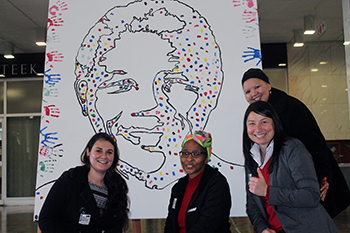Latest News Archive
Please select Category, Year, and then Month to display items
12 January 2024
|
Story Nonsindiswe Qwabe
|
Photo Sonia Small
 Since joining the UFS in 2008, Dr Grey Magaiza has worked extensively on approaches that can foster the socio-economic transformation of societies.
Since joining the UFS in 2008, Dr Grey Magaiza has worked extensively on approaches that can foster the socio-economic transformation of societies.
“The future should be one where communities can decide on their development agenda and futures. That’s the most important for me.” Dr Grey Magaiza, Deputy Director of the Centre for Gender and Africa Studies (CGAS) and Head of the Community Development programme on the Qwaqwa Campus, is passionate about capacitating communities to be agents of change and advancement. His vision for the future emphasises the empowerment of communities to take charge of their development by actively participating in decision making and the implementation of development projects that can improve their lives.
Since joining the UFS in 2008, Dr Magaiza has worked extensively on approaches that can foster the socio-economic transformation of societies. Over the years, he has crafted his research speciality into one that he is most proud of – being an interdisciplinary scientist immersed in the development of communities.
“I’m in a fortunate position of researching what I like. I say ‘fortunate’, because I’ve taken the time to understand what I’m passionate about, which is the overall field of rural livelihoods and livelihood futures – in short, community development. My research starts from an engaged university, understanding the elements that a university must use to enhance transformation and relevance to its immediate community in terms of development.”
One of the ways he has done this is by looking at social entrepreneurship as a development approach for young people in a rural setting. Through workshops with non-profit and civic organisations in Qwaqwa, Dr Magaiza has been helping these organisations to map out their needs and actively meet them through the involvement and support of external role players.
“We understand that communities are part of the national development agenda, but even that national agenda respects community knowledge and intentions and allows communities to shape their identity. A critical enabler of this is community organising. You bring back the capacity in communities to have dialogues on issues affecting them as spaces for engagement, knowledge exchange, and for people to just talk about their way forward.”
By enabling communities to define their development agenda, they can address their specific needs, challenges, and aspirations, he said. “When I look at livelihood futures, it’s quite an exciting aspect of my work – it’s like looking into a fortune tellers’ globe, because you’re not deciding for communities what they should do, but the communities themselves take those decisions.”
Students come together to commemorate Mandela
2016-08-18

Where there is teamwork and collaboration, wonderful results are bound to follow. Students from the School of Allied Health Professions at the Faculty of Health Sciences demonstrated this in their collaboration with students from the Department of Fine Arts to pay homage to Mandela, through a Nelson Mandela-inspired art piece.
Fingerprint donations go a long way
Creating a portrait of the icon on a canvas, they invited members of the university to take part in completing the portrait with their fingerprints, for a small fee. The initiative was aimed at celebrating the life of the world leader. And in true Madiba spirit, the contributions collected were donated to the university’s ‘No Student Hungry’ (NSH) programme. The programme provides less privileged students with the necessary nourishment to excel in their academic studies.
UFS community embodies selflessness
Vicky Simpson of the NSH programme said that initiatives such as these reveal the true spirit of compassion and sense of commitment found in members of the UFS community. “NHS is sincerely grateful to each and every person who made a contribution. It will surely go a long way”. The day was sealed with special performances by Occupational Therapy and Physiotherapy students.
More opportunities for student participation and involvement in completing the artwork will be presented in future.